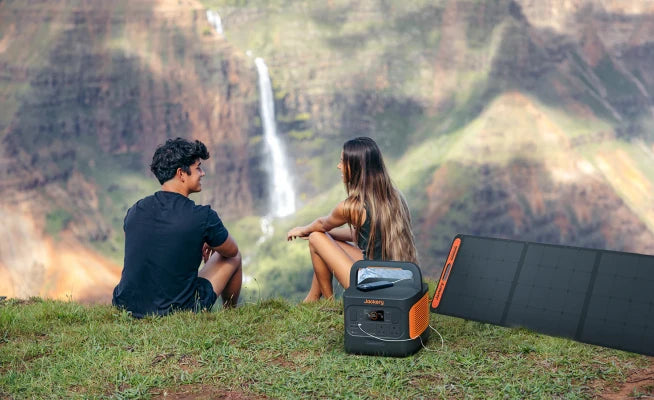Hiking is an exercise that requires significantly more of your lower body than your upper body. Well, unless you're scrambling. What does it mean to scramble while hiking? Scrambling, as used in hiking, refers to using your hands in addition to your feet to make progress across steep, rugged terrain.
Scrambling is not only more entertaining than hiking, but it also provides a more physically demanding full-body workout. If you've never heard of scrambling or are only vaguely familiar and anxious to learn more, you won't want to miss this one. We'll explain scrambling in hiking, discuss its complexity, and offer some advice to help you improve your scrambling abilities.
|
Key Takeaways: |
|
What Is Scrambling in Hiking?
Although it is a hiking activity, scrambling differs significantly from hiking. Many hiking trails include the occasional rocky step that requires a bit of scrambling to continue. Scrambling exists in the grey region between hill walking and rock climbing.
Scrambling is the act of carefully moving through rocky, often exposed backcountry terrain using both hands and feet. When scrambling, you use your hands and feet to ascend the terrain. In other words, you're usually scrambling if you need to use both your hands and your feet to keep moving forward.
Scrambling is an excellent outdoor activity for testing yourself on the hill, staying healthy, and discovering new parts of a hilly landscape that you would not otherwise be able to explore. As we indicated in the introduction, scrambling encompasses parts of rock climbing, mountaineering, hillwalking, and hiking.
Is Scrambling Difficult?
Scrambling can be exceedingly difficult, but, like bouldering and climbing, it offers a range of difficulty levels. Countries around the world utilise various systems to grade the complexity of scrambling routes. In the United Kingdom, scrambling difficulty is categorised from 1 to 3, with Grade 1 being the easiest and Grade 3 being the most demanding.

Grade 1
The easiest grade, requiring only occasional hand use for balance. Similar to a steep, exposed walk. Some paths can be risky, so go with caution. Examples of Grade 1 UK scrambles are Crib Goch on Yr Wyddfa (Snowdon) and Striding Edge in the Lake District.
Grade 2
In Grade 2, routes grow more challenging, with longer exposed parts and more complex moves. Climbing may involve both hands and basic rock climbing skills. Grade 2 UK scrambles include Torridon's Liathach Traverse and Glencoe's Aonach Eagach.
Grade 3
The most difficult grade, with extensive parts of steep rock climbing. Routes can be challenging to follow and climb, with long rock climbs and significant exposure. Grade 3 UK scrambles include Curved Ridge on Buachaille Etive Mòr, Lake District's Pinnacle Ridge, and Elbow Ridge in the Peak District.
Techniques to Improve Your Scrambling
Improving your scrambling skills requires not only a physical foundation but also skills, mental preparation, and experience.

Technique 1: Boosting Strength and Endurance
When you have free time, cross-training at the gym is a great way to prepare your muscles for scrambling and keep them strong. Exercises should target your legs, core, arms, and hands. Alternatively, strengthen your leg muscles and adapt to long scrambling sessions through long hikes, stair climbing, squats, and other exercises.
Technique 2: Always Maintain Three Points of Contact
When scrambling, you should always have both hands and one foot firmly placed. The only time you should have three points of contact is when you actively move a limb to a new position. Furthermore, look for strong footholds (where your feet plant) and handholds (where your hands may hang on), rather than relying on loose rock.
Technique 3: Practice Makes Perfect
The first step towards improving your scrambling technique is practice. Go out scrambling as often as you can, but be aware of your limitations. This means that to move securely and efficiently across rugged terrain, you must build mileage gradually. Look for diversity in as many terrain types as feasible. Explore ridges, gullies, slabs, and steps, both wet and dry.
Technique 4: Risk Assessment
When scrambling, you can't just keep moving forward and hope for the best. You must be aware of your surroundings and any potential threats, such as changing weather, unstable ground, or a depleting water supply. You can safely improve this talent over time by beginning with simple routes and progressing as you gain experience.
Technique 5: Take a Professional Course
For novices, the most effective approach to develop your scrambling skills is to enrol in an indoor introductory course and receive professional training from an expert. However, greenhorns should keep in mind that dealing with exposure requires both mental focus and physical ability.
How to Find a Scrambling Route?
Many scrambles are cross-country treks with little to no guidance other than faint tracks or cairns. The ability to read the landscape and decide the safest, most efficient way is a crucial talent. This includes studying topographic maps, identifying and avoiding potential hazards, and utilising a compass or GPS device to navigate. Following these tactics will help you discover new routes and be better prepared.

Method 1: Use Professional Maps
Maps such as Ordnance Survey (OS) Maps clearly show the topography, pathways, and landmarks. Many scrambling routes are indicated on the map with dotted lines or distinctive symbols.
Method 2: Use Online Websites
On services such as AllTrails, you may filter scrambling routes and see other users' tracks, difficulty ratings, and safety advice. Some applications also provide offline maps.
Method 3: Consult Professional Guides
Purchase or borrow specialised UK scrambling guidebooks, such as Cicerone Publishing's Scrambles in Snowdonia and Scrambles in the Lake District - South. These instructions describe the route's difficulty, beginning site, duration, and precautions.
Remember, on your first attempt, choose routes that are moderately difficult, easy to find, and simple to follow, and avoid inescapable, treacherous routes. This is especially important if you're travelling alone.
What Gear Do You Need for Scrambling?
With a few significant variations, the gear list for a scramble is nearly identical to that for a walk. Here are the items to pay special attention to.
Helmet
Wearing a climbing helmet is recommended when scrambling, especially in steep, unstable gullies where rockfall from above is a risk.
Shoes
Trail running shoes or rock climbing shoes are comfortable, have good grip, and quickly absorb and drain water. Secondly, lightweight hiking boots provide support and protection, especially when climbing unstable rocks.
Rope
Although most scrambling is done unroped, a rope should be taken and used when the leader believes the less confident may need reassurance or to guard a particularly tough pitch, such as those on Grade 3 or higher routes.
Extra Food, Water, Clothing, and Supplies
When scrambling, pack your rucksack with more food and drink than you would for a walk. Be conservative with attire and gear. If in doubt, pack a rain jacket, an additional warm layer, a headlamp, or an emergency bivvy.
First Aid Kit
You should always carry a small first-aid kit while hiking, especially when scrambling, where minor injuries such as scratches and sprains are more common.
Portable Power Supply
Although traditional scrambling emphasises lightweight, low reliance on electronic devices, a portable power supply is required for charging mobile phones, headlamps, GPS devices, etc.
Satellite Messenger
If you twist an ankle, get lost, or encounter inclement weather, this small device will literally save your life.
Backpack
The rucksack is used to transport all personal belongings. It must fit the back and include a chest strap and a waist belt to ensure stability. It is recommended that you use a 25-40 litre backpack that is lightweight and waterproof, or one with a waterproof cover.

Jackery Explorer 240 vv2: Empowering Your Scrambling Experience
Scrambling is an outdoor sport that combines trekking, rock climbing, and discovery. It is typically done in rough alpine environments, rocky terrain, or unpredictable paths, which require a high level of physical fitness, equipment, and flexibility. In such harsh conditions, power supply is critical for assuring safety, documenting journeys, and keeping equipment operational.
As a well-known brand in portable energy storage, Jackery's products play a vital role in scrambling, increasing the experience in several ways. The Jackery Explorer 240 v2, with its steady performance, flexible charging options, and versatility, is a terrific addition to the scrambling experience. Here's why the Jackery Explorer 240 v2 has become an indispensable power hub for scrambling adventurers:
Jackery Explorer 240 v2
Choosing the Jackery Explorer 240 v2 for a trip that involves scrambling (a mix of hiking and easy rock climbing) primarily comes down to its portability and durability for outdoor use, combined with sufficient power for essential electronics. Here are the key reasons why it would be a good choice for scrambling and similar rugged outdoor adventures:

Portability for the Trail: Weighing in at approximately 7.94 lbs (3.6 kg), the Explorer 240 v2 is considered one of the more portable power stations in its capacity class. For scrambling, where every pound matters, this relatively low weight is a significant advantage for backpack carrying. The dimensions (approx. 9.1 x 6.0 x 6.6 in) are small enough to easily fit into a backpack, which is crucial for maintaining balance and freedom of movement while climbing or traversing rugged terrain.
Reliable and Robust Power: The v2 model features a LiFePO4 (Lithium Iron Phosphate) battery chemistry, which is generally more stable and durable, with a longer lifespan (up to 3,000 cycles), providing peace of mind in challenging outdoor conditions. While not for heavy-duty appliances, 256Wh is more than enough to keep essential electronics charged for a weekend trip.
Durability and Outdoor Readiness: The unit is designed with a sturdy plastic shell and robust safety features, suggesting it can withstand the typical bumps, scrapes, and knocks of rugged outdoor use, such as scrambling. The ability to recharge via compatible Jackery SolarSaga solar panels means you can keep it topped up even on multi-day trips deep in the wilderness, providing a continuous power source far from any wall outlet.
|
Features of Jackery Explorer 240 v2 |
|
|
Portability |
7.94 lbs (approx. 3.6 kg) |
|
Battery Capacity |
256Wh Provides reliable charge for essential electronics (phone, headlamp, GPS/satellite communicator, camera batteries) over a multi-day trip. |
|
Battery Type |
LiFePO4 Battery 3,000 cycles to 80%+ capacity |
|
AC Output (Pure Sine Wave) |
1 x 100W Max (Input/Output), 1 x AC Outlet, 1 x USB-A (15W Max), 1 x 15W USB-C, 1 x 12V Car Port |
|
Operating Temperature |
Discharge: 14°F to 113°F (-10°C to 45°C) |
|
Running Time |
GPS Device (5W): 21 Hrs Camping Light (5W): 21 Hrs Portable Fridge (60W): 4 Hrs Phone (29W): 11 Times Drone (90W): 4.5 Times |
What Are the Dangers of Scrambling and How Can You Avoid Them?
The danger of scrambling is determined by a variety of factors, including where you are climbing, how well your skill level matches the terrain, and the judgments you make as you go. Below, we'll look at the pitfalls of scrambling and how to avoid them.

Is Scrambling Dangerous?
Scrambling can be harmful in some circumstances, although most casual scrambling is very harmless. Here's a summary of the hazards you should be aware of when scrambling:
Exposure
Rock falls from above
Shifting rocks and the risk of lower limb injury
Navigation challenges
Weather Challenges
Remoteness and the demand for self-reliance
Mental obstacles, such as dealing with heights
Safety Tips for Scrambling
Here are some basic tips for scrambling as safely as possible.
Safety Tip 1: Take It Slow
Scrambling is neither a race nor a competition. It's about having fun and appreciating the process as you go. Slow scrambling is a safe scramble. Going slowly allows you to plan your next move while maintaining your equilibrium safely.
Safety Tip 2: Wear Gloves
Wearing gloves while rock scrambling protects your hands from harm and gives you a better grip on rugged terrain. Look for gloves with an appropriate level of grip so that you don't slip when grasping each handful of rock.
Safety Tip 3: Test Hand and Foot Placements
Do not fully weight your foot or hand until you have tested the stability of the rock underneath it. When using your hands to move upward, pull gently downward rather than outward on any suspect grip.
Safety Tip 4: Go with a Buddy
Scrambling, like many other outdoor sports, is safer when done in groups rather than alone. However, travelling with a group necessitates even greater caution and attention to one's surroundings. Never hike straight above or below another hiker.
Safety Tip 5: Be Prepared to Turn Back
When tackling a new scrambling route, it can be difficult to predict whether any portions will be outside your personal zone of acceptable danger. Weather and time can also necessitate an early reversal, given scrambling's slower, less predictable nature.
What Is the Difference between Hiking and Scrambling?
Hiking and scrambling are two mountain activities often linked but fundamentally different. There are significant differences between the two in terms of path difficulty, technical requirements, degree of danger and equipment requirements.
Path Difficulty
Hiking is mostly on clear trails, such as forest paths, ridgelines, and well-built trails, which are usually clearly marked. The terrain is mainly dirt, grass, and gravel. Scrambling is mostly on steep, gravelly, rocky, or ridgeline terrain without clear paths, and you need to find a feasible route on your own. The terrain is complex and often requires your hands and feet to maintain balance and move upwards.
Technical Requirements
The core of hiking is walking, with low technical requirements and more emphasis on physical fitness and perseverance. Only basic outdoor knowledge is required, such as navigation, weather judgment, and physical energy distribution. Scrambling requires basic climbing skills, including how to distribute the body's centre of gravity and stay calm in exposed terrain.
Risk Level
The primary risks of hiking are environmental and personal, including unexpected storms, getting lost, dehydration, and exhaustion. On most established hiking trails, the greatest danger is likely a slip, which typically results in only a sprain or scrape. Scrambling, on the other hand, presents risks such as falls, falling rocks, slips, high exposure, and difficulty rescuing.
Equipment Required
Hiking requires primarily basic equipment, such as hiking boots, trekking poles, a backpack, water, food, clothing, and navigation tools. Scrambling, on the other hand, requires additional safety gear such as a helmet, rope, and harness.
FAQs
The following are the frequently asked questions about scrambling and hiking:
1. What is scrambling in hiking for beginners?
Scrambling is a type of hiking in which you use your hands and feet to traverse steep, rocky terrain, somewhere between ordinary hiking and rock climbing. For beginners, it involves using your hands to balance and move over rough terrain, often using the "three points of contact" method. It is more difficult than a typical walk but does not necessitate the same technical abilities or equipment as climbing.
2. Is scrambling difficult?
Scrambling can be easy or tough, depending on the path and your skill, and it falls somewhere between hiking and rock climbing. Routes are classified from 1 to 3, with Grade 1 being the simplest and Grade 3 being the most challenging. A simple Grade 1 scramble may feel like a difficult hike, whereas a sophisticated Grade 3 scramble demands technical skills, can be exposed, and frequently requires ropes.
3. What is the difference between hiking and scrambling?
Hiking is defined as walking on established pathways with little or no use of your hands, whereas scrambling requires you to use both your hands and your feet to travel across steep, rocky terrain. Furthermore, trekking has fewer risks, such as sudden storms, getting lost, dehydration, and weariness.
Scrambling, on the other hand, involves risks such as falls, falling rocks, slips, excessive exposure, and challenging rescues. Furthermore, scrambling necessitates additional equipment, such as helmets and ropes, in addition to standard hiking gear.
4. Can beginners go scrambling?
Yes, beginners can try scrambling, but they should start with easy, Grade 1 routes in excellent weather, preferably with an experienced person or guide. It is recommended to wear sturdy hiking boots and appropriate attire. For most beginning scrambles, a helmet and a small rope can provide extra safety on difficult sections.
Final Thoughts
Scrambling is a hiking technique in which you climb steep terrain using your hands and feet. It mixes rock climbing, mountaineering, hillwalking, and hiking in one. Scrambling requires a helmet, ropes, and other basic equipment, such as a rucksack. A portable power supply, such as the Jackery Explorer 240 v2, ensures safety in extreme scrambling settings, tracks your progress, and keeps your equipment running smoothly. To improve your scrambling, you will need significant training, particularly in your legs, core, arms, and hands.


































































































